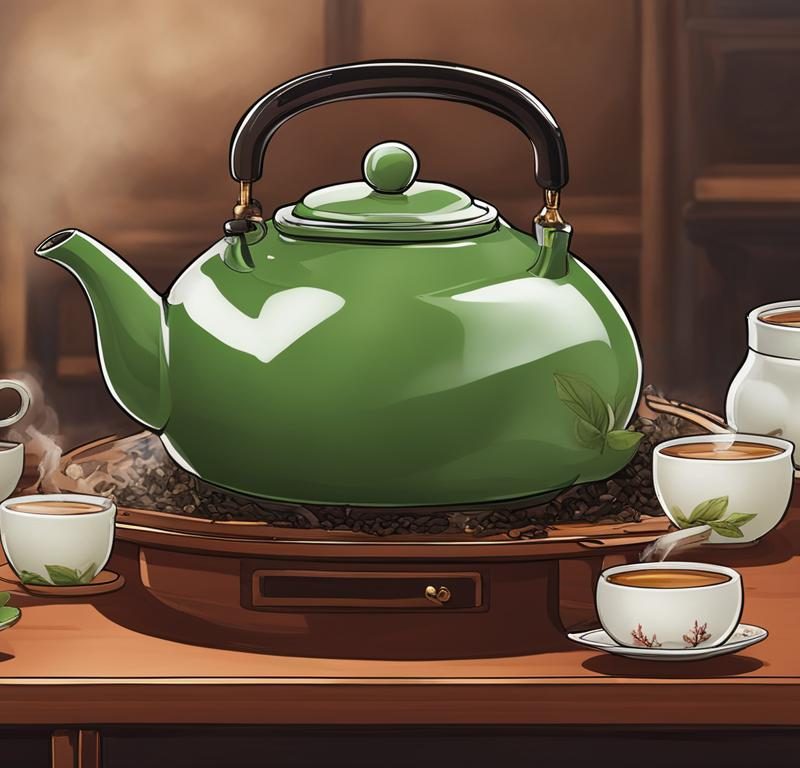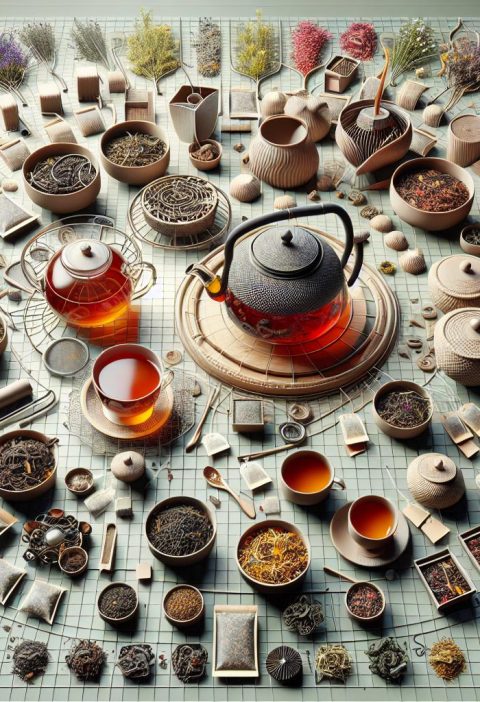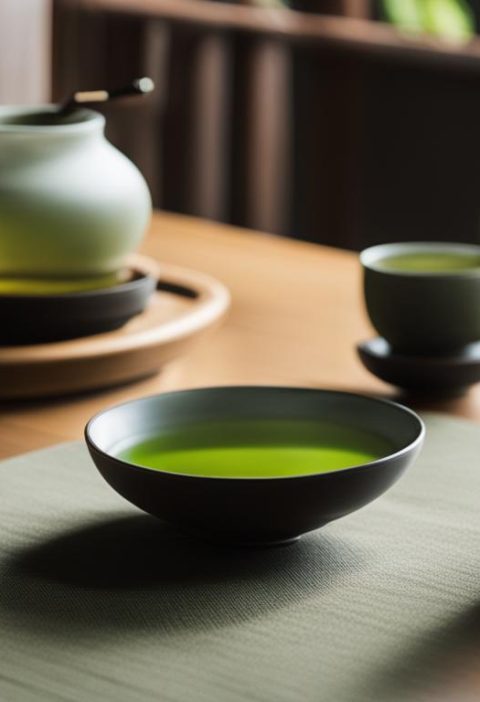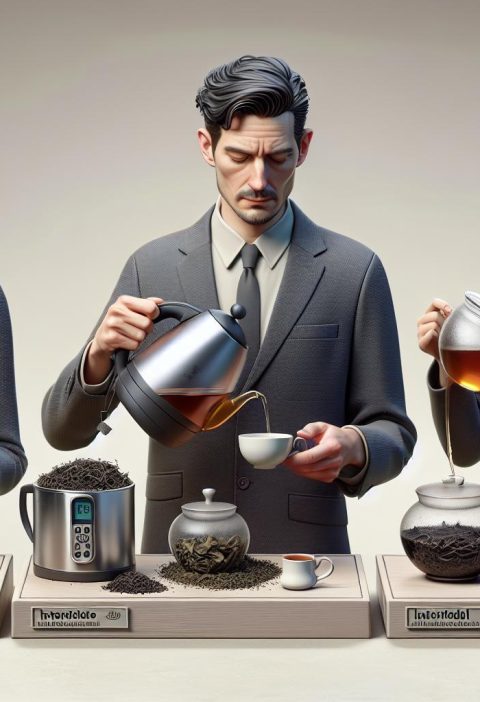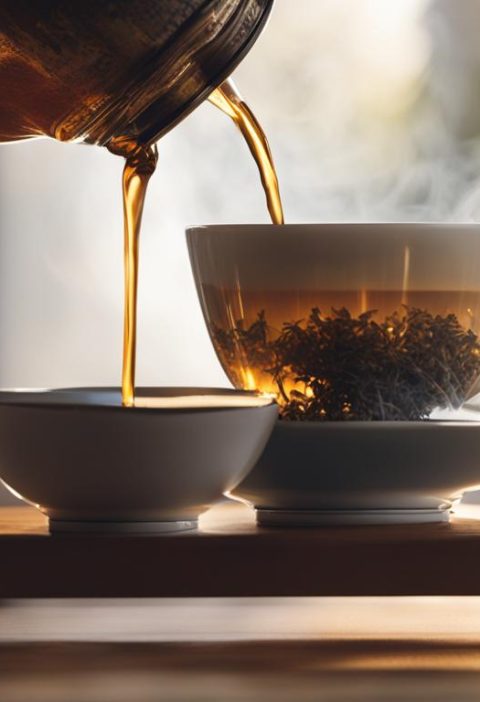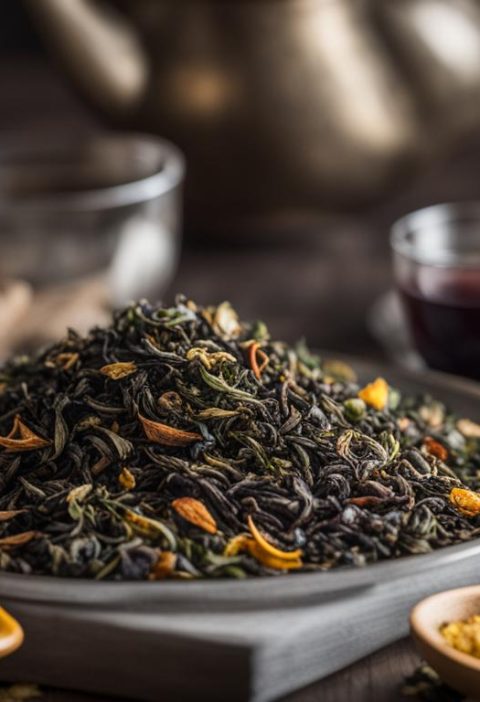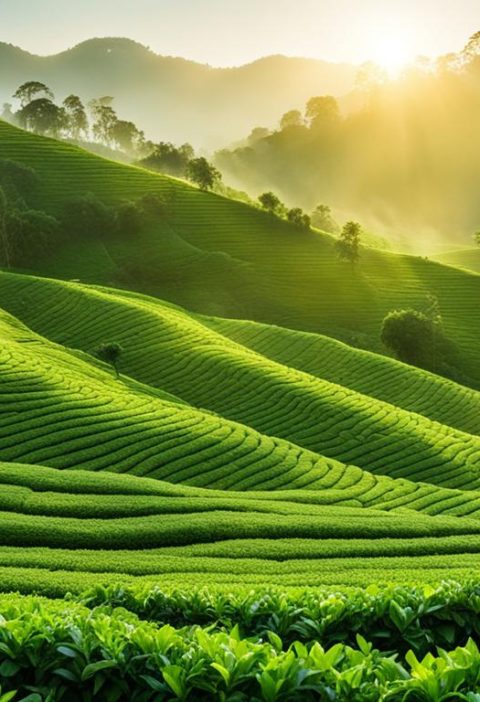Steeping black tea is not just a simple process of pouring water over tea leaves. It requires finesse, attention to detail, and an understanding of the factors that contribute to the aroma and flavor of black tea. By following the right steeping techniques and paying attention to key elements such as water temperature, steeping time, and the quality of the tea and water used, you can unlock the full potential of black tea’s aroma and taste. In this article, we will guide you through the art of steeping black tea to help you achieve maximum aroma and indulgence in every sip.
Key Takeaways:
- Steeping is the process of extracting flavor and health-promoting compounds from tea.
- Use fresh ingredients for herbal tea and store dried tea leaves properly.
- The quality of water affects the flavor of tea, so use fresh, cold, and filtered water.
- Different types of tea require different steeping techniques.
- Steeping time and temperature can impact the flavor and caffeine content of tea.
Different Types of Tea and Steeping Techniques
When it comes to maximizing the flavor and aroma of tea, understanding the different types of tea and their corresponding steeping techniques is key. True teas, including black, green, oolong, and white tea, all come from the Camellia sinensis plant but differ in their oxidation levels, resulting in varying flavors and antioxidant contents. Herbal teas, on the other hand, are crafted from a variety of herbs and plants, each requiring specific steeping techniques based on whether they are made from dried or fresh ingredients.
Let’s explore the optimal steeping tips for each type of tea:
True Teas: Black, Green, Oolong, and White Tea
True teas, derived from the Camellia sinensis plant, offer a wide range of flavors and health benefits. Here are some general steeping tips to ensure maximum flavor:
- Steeping Time: The steeping time for each type of true tea may vary. Generally, green tea requires a shorter steeping time of around 1-2 minutes, while black tea can be steeped for 3-4 minutes. Oolong tea falls somewhere in between with a recommended steeping time of 2-3 minutes. White tea typically requires a longer steeping time of 4-5 minutes to extract its delicate flavors.
- Water Temperature: The water temperature for steeping true teas also differs. For green tea, a lower water temperature of around 170-180°F (77-82°C) is ideal to prevent bitterness. Black tea can be steeped at a slightly higher temperature of 195-205°F (90-96°C) to enhance its bold flavors. Oolong tea benefits from a water temperature of 185-205°F (85-96°C), while white tea should be steeped at a lower temperature of 160-180°F (71-82°C).
Herbal Teas: Dried and Fresh Ingredients
Herbal teas offer a wide variety of flavors and can be crafted from both dried and fresh ingredients. Here’s what you need to know:
- Steeping Time: The steeping time for herbal teas depends on the ingredients used. Generally, dried herbal teas require longer steeping times of around 5-7 minutes, while fresh herbal teas can be steeped for a shorter duration of 3-5 minutes. These steeping times allow the herbs to release their flavors and beneficial compounds effectively.
- Water Temperature: For dried herbal teas, boiling water can be used to fully extract the flavors. On the other hand, fresh herbal teas benefit from slightly lower water temperatures of around 180-190°F (82-88°C) to preserve their delicate flavors.
By following these recommended steeping times and water temperatures, you’ll be able to unlock the optimal flavors and aromas of each type of tea, ensuring a truly satisfying tea drinking experience.
Steeping Time and Temperature for Black Tea
To achieve the perfect cup of black tea with enhanced aroma, it’s essential to pay attention to the steeping time and temperature. Steeping black tea for too long or at too high of a temperature can result in a bitter taste that overpowers the delicate flavors and aromas.
We recommend steeping black tea for 3-4 minutes at a water temperature of 195°F (91°C). This allows the tea leaves to infuse the water, releasing the desired flavors and aromas without extracting too much bitterness. Steeping black tea for longer than 4 minutes or using boiling-temperature water can increase the caffeine content of the tea, which may affect your overall tea-drinking experience.
By following the recommended steeping time and temperature, you’ll be able to enjoy a well-balanced cup of black tea with a delightful aroma that invigorates your senses.
| Steeping Time | Water Temperature |
|---|---|
| 3-4 minutes | 195°F (91°C) |
Hot Steeping vs. Cold Steeping
In our quest to achieve the maximum flavor and rich aroma in black tea, we have explored various steeping techniques. One key consideration is the temperature at which we steep our tea. Two popular methods are hot steeping and cold steeping, each with its own unique benefits.
Hot Steeping
Hot steeping is the traditional and widely used method of preparing tea. It involves pouring hot water over the tea leaves and allowing them to steep for a few minutes. The recommended water temperature for hot steeping black tea is typically around 195°F (91°C) to avoid any bitterness. This method provides a quicker infusion and releases the flavors and aroma of the tea leaves in a relatively short time.
Cold Steeping
On the other hand, cold steeping is a more gentle and extended process. It involves steeping tea leaves in cold or room temperature water for a longer period, usually up to 12 hours. Cold steeping is known to result in a smoother and less astringent taste, with a higher concentration of antioxidants. This method is particularly popular for cold brews, iced teas, and herbal infusions.
When deciding between hot steeping and cold steeping, it is essential to consider your desired flavor profile and the specific tea you are using. Hot steeping offers a quicker infusion and the ability to control the strength of the tea by adjusting the steeping time. Cold steeping, on the other hand, provides a smoother and more refreshing taste, with a higher concentration of certain compounds.
Experiment with both methods to discover your preferred steeping technique. Whether you choose hot or cold steeping, adjusting the steeping time and water temperature accordingly is crucial to achieve the desired flavor and aroma in your black tea.
Tools and Techniques for Steeping Tea
When it comes to steeping tea, there are a variety of tools and techniques available to help you achieve the perfect brew and unlock the rich aromas and flavors of your tea leaves.
One of the most common tools for steeping loose leaf tea is a metal tea ball or infuser. These handy devices allow you to steep the tea without the leaves floating freely in the water. Simply place the desired amount of tea leaves inside the infuser, close it, and immerse it in your teacup or teapot.
If you don’t have a tea infuser, don’t worry! You can still enjoy a delicious cup of tea using simple tools you probably already have at home. A teacup and a tea bag are all you need. Just place the tea bag in the cup and pour hot water over it. The tea bag will contain the tea leaves and infuse the water with their flavors and aromas.
When it comes to measuring the right amount of tea, refer to the brewing instructions provided by the tea company or use your personal preference as a guide. Generally, one teaspoon of loose leaf tea is enough for an 8-ounce cup. Adjust the amount according to your taste preferences and the strength of the tea.
The quality of water used for steeping is crucial for a flavorful cup of tea. Opt for fresh, cold, and filtered water to avoid any unwanted flavors or impurities. The water temperature is also important and varies depending on the type of tea you are steeping. Black tea, for example, typically requires water at a temperature of 200-205°F (93-96°C) to bring out its rich flavors.
Remember, steeping loose leaf tea offers more variety and the opportunity to re-infuse the leaves for multiple cups. So, grab your favorite tea tools and explore the world of tea steeping to unlock a rich, aromatic experience.
The Importance of Fresh Ingredients and Quality Water
When it comes to steeping tea for a rich aroma, using fresh ingredients and quality water is essential. Whether you’re making herbal tea with fresh herbs or using high-quality dried tea leaves, the freshness of your ingredients can greatly enhance the flavor and aroma of your tea.
Properly storing dried tea leaves is crucial to maintain their quality over time. Make sure to store them in airtight containers away from moisture, heat, and strong odors. This will help preserve the freshness and integrity of the tea leaves, ensuring a more flavorful and aromatic brew.
But it’s not just the ingredients that impact the overall flavor of your tea. The quality of water used for steeping also plays a significant role. Fresh, cold, and filtered water is recommended to avoid any off-flavors or impurities that could diminish the true aroma of the tea.
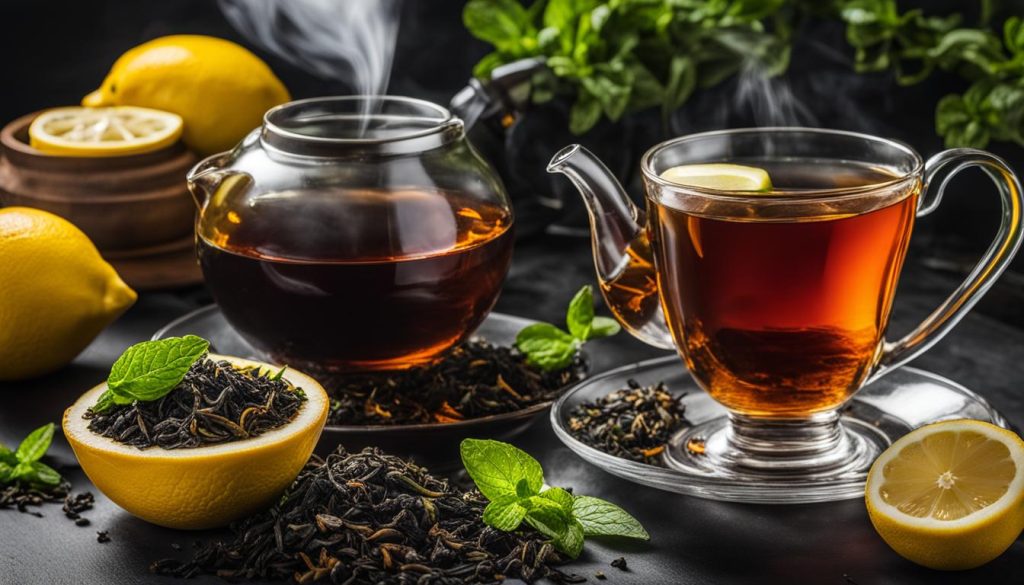
Steeping Techniques for Different Types of Tea
Each type of tea requires specific steeping techniques to bring out its optimal flavors and aromas. Whether you’re brewing a delicate green tea, a soothing herbal tea, or a robust black tea, understanding the right steeping methods is key to achieving a rich tea aroma and maximum flavor.
Green Tea and White Tea
Green tea and white tea are more delicate compared to other types of tea. To preserve their subtle flavors, it’s recommended to steep them at lower water temperatures and for a shorter period. Heat water to around 175°F (79°C) and steep green tea for 2-3 minutes. For white tea, use slightly cooler water at around 165°F (74°C) and steep for 1-2 minutes. These shorter steeping times and lower temperatures will help maintain the delicate and nuanced flavors of green and white teas.
Oolong Tea and Black Tea
Oolong tea and black tea can withstand higher water temperatures and longer steeping times compared to green and white teas. For oolong tea, use water heated to about 195°F (91°C) and steep for 3-4 minutes. Black tea, known for its bold and robust flavors, benefits from a longer steeping time. Use water around 200-205°F (93-96°C) and steep black tea for 3-5 minutes to extract its full flavor profile.
Herbal Teas
Herbal teas, made from a variety of herbs and plants, have their own unique steeping requirements. Dried herbal teas are best steeped with freshly boiled water. Use water around 212°F (100°C) and steep for 5-7 minutes to release the flavorful compounds. Fresh herbal teas, such as those made from fresh mint leaves or chamomile flowers, can be steeped in hot water at a similar temperature for 3-5 minutes.
Remember to adjust steeping times based on personal preference. Longer steeping times may result in a stronger flavor, while shorter steeping times can yield a milder taste. Experimenting with steeping techniques allows you to customize your tea experience and discover the perfect balance of aroma and flavor.
To help you visualize the optimal steeping techniques for different types of tea, refer to the table below for a quick guide:
| Tea Type | Water Temperature | Steeping Time |
|---|---|---|
| Green Tea | 175°F (79°C) | 2-3 minutes |
| White Tea | 165°F (74°C) | 1-2 minutes |
| Oolong Tea | 195°F (91°C) | 3-4 minutes |
| Black Tea | 200-205°F (93-96°C) | 3-5 minutes |
| Herbal Tea (Dried) | 212°F (100°C) | 5-7 minutes |
| Herbal Tea (Fresh) | 212°F (100°C) | 3-5 minutes |
By following these steeping techniques, you can maximize the aroma and flavor of each type of tea and elevate your tea-drinking experience.
Brewing Ratios and Temperature for Black Tea
When it comes to brewing black tea, achieving the perfect balance of flavors and aromas is essential. The brewing ratios and temperature play a crucial role in bringing out the best qualities of black tea. Here are some tips to help you achieve a rich tea aroma and maximum flavor through proper steeping:
Brewing Ratios
To start, it is recommended to use 1-2 teaspoons of tea leaves per 8 ounces of water. This ratio can be adjusted based on personal preference and the specific type of black tea you are steeping. Experimentation is key to finding the perfect balance that suits your taste.
Water Temperature
The water temperature for black tea should be around 200-205°F (93-96°C). This temperature range allows the tea leaves to release their flavors and aromas without becoming bitter. However, water temperature can also vary depending on the specific type of black tea. For example, delicate black teas may require slightly lower temperatures, while robust black teas can tolerate slightly higher temperatures.
It is important to note that water that is too hot can result in a bitter taste, while water that is too cool may not extract the full range of flavors from the tea leaves. Finding the right balance is essential for achieving the desired taste and aroma.
Experiment and Adjust
Every tea lover has their own preferences when it comes to brewing ratios and temperatures. Don’t be afraid to experiment and adjust until you find the combination that produces the best results for you. Remember, the goal is to enhance the rich tea aroma and maximum flavor of black tea through proper steeping.
| Tea Type | Recommended Brewing Ratios | Recommended Water Temperature |
|---|---|---|
| Assam | 1-2 teaspoons per 8 ounces of water | 200-205°F (93-96°C) |
| Darjeeling | 1-2 teaspoons per 8 ounces of water | 195-200°F (91-93°C) |
| Ceylon | 1-2 teaspoons per 8 ounces of water | 200-205°F (93-96°C) |
Brewing Techniques for Black Tea
When it comes to steeping black tea, two common methods are using tea bags or loose leaf tea. Let’s explore the brewing techniques for each:
Tea Bags
To make a cup of black tea using tea bags, simply follow these steps:
- Place a tea bag in a teacup.
- Pour hot water over the tea bag.
- Cover the teacup with a saucer during steeping to help retain more aromatic compounds.
- Let the tea steep for the recommended time (usually 3-4 minutes, but this can vary).
- Remove the tea bag and enjoy!
Using tea bags is a convenient way to enjoy a quick cup of black tea. However, keep in mind that the flavor and aroma may be more subtle compared to brewing with loose leaf tea.
Loose Leaf Tea
If you prefer to use loose leaf tea, here’s how to brew black tea:
- Use a metal tea ball or infuser to hold the loose tea leaves.
- Place the tea ball or infuser in a teacup.
- Pour hot water over the tea leaves.
- Cover the teacup with a saucer, if desired.
- Allow the tea to steep for the recommended time, which can vary depending on the type of black tea and your personal preference.
- Remove the tea ball or infuser.
- Savor the rich aroma and flavor of your freshly brewed black tea.
Using loose leaf tea provides a more customizable and robust tea experience. You have the flexibility to adjust the amount of tea leaves, water temperature, and steeping time to suit your taste preferences.
Brewing black tea is an art that can be perfected with practice and experimentation. Take the time to explore different brewing techniques and find what works best for you. And remember, the key to a rich tea aroma and maximum flavor is proper steeping!
| Brewing Method | Pros | Cons |
|---|---|---|
| Tea Bags | – Convenient and easy to use – Portable for on-the-go tea – Less cleanup required |
– Flavor and aroma may be more subtle – Limited control over tea quality and steeping parameters |
| Loose Leaf Tea | – Customizable brewing experience – Richer flavor and aroma – Higher tea quality and freshness |
– Requires additional equipment like tea ball or infuser – More cleanup involved |
Tips for Enhancing the Aroma of Black Tea
To enhance the aroma of black tea, we recommend trying different flavor combinations using complementary ingredients. Adding milk, sweeteners, spices, or fruit can elevate the experience and create a delightful sensory journey. Here are some tips to boost the aroma of your black tea:
- Milk: Pouring a splash of milk into your black tea can add creaminess to the brew, enhancing its overall texture and flavor.
- Sweeteners: Experiment with sweeteners like sugar or honey to enhance the natural sweetness of black tea. These additions can elevate the aroma and taste profile.
- Spices: For a flavorful twist, try incorporating spices like cinnamon or ginger. These spices bring warmth and depth to the aroma, creating a comforting and aromatic experience.
- Fruit: Adding fruit flavors to your black tea can provide a refreshing twist. Consider infusing your tea with citrus fruits like lemon or orange, or experiment with other fruits to find your perfect combination.
By exploring different flavors and combinations, you can create a truly personalized and aromatic black tea experience. Find the blend that best complements your taste preferences and enjoy the rich aroma that proper steeping can bring.
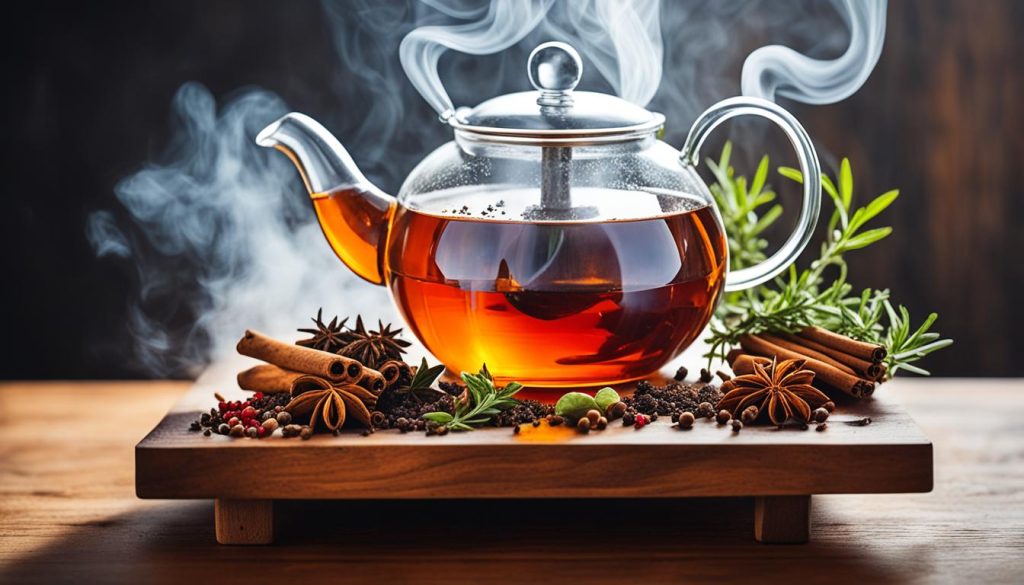
| Additions | Effect |
|---|---|
| Milk | Adds creaminess and smoothness to the tea, enhancing the overall texture and mouthfeel. |
| Sweeteners (Sugar or Honey) | Enhances the natural sweetness of black tea, adding depth and richness to the flavor profile. |
| Spices (Cinnamon or Ginger) | Brings warmth and complexity to the aroma, creating a comforting and aromatic experience. |
| Fruit (Citrus or Other Fruits) | Provides a refreshing twist to the aroma, infusing the black tea with fruity undertones. |
Tea Recipes to Try with Black Tea
Expand your culinary repertoire by incorporating black tea into your favorite recipes. This versatile ingredient adds a rich flavor and aroma to a variety of dishes. Here are some popular tea recipes that are sure to delight your taste buds:
1. London Fog Latte
Indulge in a comforting cup of London Fog Latte, which combines the robust flavor of black tea with the creamy goodness of steamed milk. This classic beverage is perfect for chilly mornings or relaxing evenings. To make it, steep black tea in hot water for the recommended time, then combine it with steamed milk and a touch of vanilla syrup. Top it off with a sprinkle of cinnamon or cocoa powder for an extra touch of elegance.
2. Raspberry Lemon Iced Tea
Refresh your senses with a tangy and fruity Raspberry Lemon Iced Tea. Start by brewing a strong pot of black tea and letting it cool. In a pitcher, muddle fresh raspberries with lemon juice and a sweetener of your choice. Add the cooled tea, plenty of ice, and a few lemon slices for garnish. Stir well and enjoy this vibrant and thirst-quenching beverage on a hot summer day.
3. Black Vanilla Cream
Indulge in the velvety smoothness of Black Vanilla Cream. This dessert-like tea is perfect for those with a sweet tooth. Steep a robust black tea and add a splash of vanilla extract. Sweeten with honey, maple syrup, or a dollop of whipped cream. Sip slowly and savor the rich flavors and comforting aroma.
4. Black, Spicy, and Unique Tea
If you’re a fan of bold and adventurous flavors, try the Black, Spicy, and Unique Tea. Steep a strong black tea and add a twist of spices like cinnamon, cardamom, and cloves. For an extra kick, you can also add a slice of fresh ginger. This warming and invigorating tea is perfect for chilly winter days or when you’re in need of a comforting pick-me-up.
These tea recipes showcase the versatility of black tea and allow you to explore new flavor combinations. Follow the specific instructions for each recipe to achieve the desired taste and aroma. Get creative and experiment with other ingredients to personalize these recipes and make them your own.
Experience the rich qualities of black tea in these delightful recipes and discover a whole new world of culinary possibilities.
Conclusion
When it comes to steeping black tea for maximum aroma and flavor, attention to detail is key. Factors such as water temperature, steeping time, and the quality of both the tea and water play crucial roles in the final result. Each type of tea has its own specific steeping techniques that bring out its unique qualities, and experimenting with brewing ratios, temperatures, and steeping times can help you find the perfect cup.
To enhance the aroma even further, consider adding complementary flavors to your black tea. Whether it’s a splash of milk for creaminess, a touch of sweetener for added sweetness, or spices and fruits to create a unique twist, the possibilities are endless. And don’t forget to explore different tea recipes that incorporate black tea as a base ingredient. These recipes allow you to fully explore the versatility of black tea and discover new and exciting flavor combinations.
Steeping black tea is both an art and a science. Through proper attention to detail and experimentation, you can unlock the rich aromas and flavors that black tea has to offer. So, sit back, relax, and enjoy the process of steeping black tea, knowing that every cup you brew holds the potential for a truly exceptional sensory experience.
